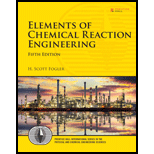Solutions for Elements of Chemical Reaction Engineering (5th Edition) (Prentice Hall International Series in the Physical and Chemical Engineering Sciences)
Problem 1.4Q:
What does a negative number for the rate of formation of species (e.g., species A), rA = 3 mol/dm3...Problem 1.5Q:
What assumptions were made in the derivation of the design equation for: (a) The batch reactor (BR)?...Problem 1.6Q:
Use the mole balance to derive an equation analogous to Equation (1-7) for a fluidized CSTR...Problem 1.1P:
(a) Revisit Example 1-1. Rework this example using Equation (3-1) on page 71. (b) Revisit Example...Problem 1.3P:
The reaction A + B 2C takes place in an unsteady CSTR. The feed is only A and B in equimolar...Browse All Chapters of This Textbook
Chapter 1 - Mole BalancesChapter 2 - Conversion And Reactor SizingChapter 3 - Rate LawsChapter 4 - StoichiometryChapter 5 - Isothermal Reactor Design: ConversionChapter 6 - Isothermal Reactor Design: Moles And Molar Flow RatesChapter 7 - Collection And Analysis Of Rate DataChapter 8 - Multiple ReactionsChapter 9 - Reaction Mechanisms, Pathways, Bioreactions, And BioreactorsChapter 10 - Catalysis And Catalytic Reactors
Chapter 11 - Nonisothermal Reactor Design-the Steady-state Energy Balance And Adiabatic Pfr ApplicationsChapter 12 - Steady-state Nonisothermal Reactor Design - Flor Reactors With Heat ExchangeChapter 13 - Unsteady-state Nonisothermal Reactor DesignChapter 14 - Mass Transfer Limitations In Reacting SystemsChapter 15 - Diffusion And ReactionChapter 16 - Residence Time Distributions Of Chemical ReactorsChapter 17 - Predicting Conversion Directly From The Residence Time DistributionChapter 18 - Models For Nonideal Reactors
Sample Solutions for this Textbook
We offer sample solutions for Elements of Chemical Reaction Engineering (5th Edition) (Prentice Hall International Series in the Physical and Chemical Engineering Sciences) homework problems. See examples below:
Chapter 1, Problem 1.4QThe given adiabatic reaction is, A→B+C If a fluidized CSTR and a PBR contains equal weights of...Chapter 3, Problem 3.1PChapter 4, Problem 4.1QChapter 5, Problem 5.2QThe given second-order liquid phase reaction which takes place in a batch reactor is as follows....Chapter 7, Problem 7.1PThe way of completing the reaction in which a reactant A has been unsuccessful in dating reactant B...Chapter 9, Problem 9.3P
Chapter 10, Problem 10.3PFor elementary reaction A⇌B, Equilibrium conversion, Xe = Kc1+Kc Therefore, Kc = Xe1−Xe Where Kc is...Chapter 12, Problem 12.1QA list of safety consideration for making and operating the chemical reactors is given below. The...The given minimum respiration rate of a chipmunk is 1.5 micromoles or 1.5×10−6 moles of O2/min. The...Chapter 15, Problem 15.2QThe given E(t) versus time graph is shown as follows. Figure 1 The expression to calculate the fluid...It is given that an irreversible first order reaction is taking place in long cylindrical reactor....Chapter 18, Problem 18.3P
More Editions of This Book
Corresponding editions of this textbook are also available below:
Elements of Chemical Reaction Engineering
4th Edition
ISBN: 9780130473943
Elements Of Chemical Reaction Engineering (international Edition)
3rd Edition
ISBN: 9780139737855
ELEMENTS OF CHEMICAL REACTION ENGR.
6th Edition
ISBN: 9780137459438
ELEM.OF CHEMICAL REACTION ENGR.
6th Edition
ISBN: 9780135486221
EBK ELEM.OF CHEMICAL REACTION ENGR.
6th Edition
ISBN: 9780135486269
Essentials of Chemical Reaction Engineering
1st Edition
ISBN: 9780132317160
ELEMENTS OF CHEM. REACTION ENGR
5th Edition
ISBN: 9780135486498
Elements of Chemical Reaction Engineering (5th Edition) (Prentice Hall International Series in the Physical and Chemical Engineering Sciences)
5th Edition
ISBN: 9780133888096
Related Chemical Engineering Textbooks with Solutions
Still sussing out bartleby
Check out a sample textbook solution.
